

|
the
lost cathedral of Cambrai
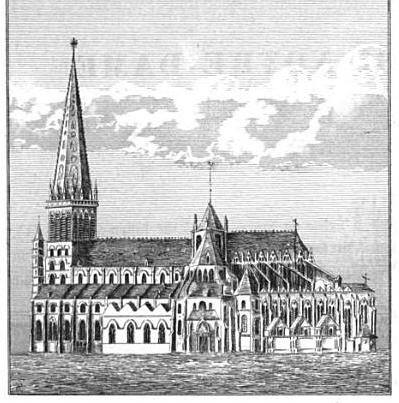
From Les
monuments religieux de Cambrai avant et depuis 1789
by Adolphe Bruyelle, published 1854, p.2
“Villard de Honnecourt [an architect from Picardy]
worked in the region where he was born. He has left
us a drawing of the chevet [choir] of the church at
Vaucelles near Honnecourt, which
he is said to have rebuilt. ‘Here is the plan’
he wrote of the chevet of Madame Sainte Marie de Cambrai,
‘just as it rises from the ground [it is built].
Later in this book you will find plans of the elevations,
including the positioning of all the side chapels, the
walls and the designs for the flying buttresses.’
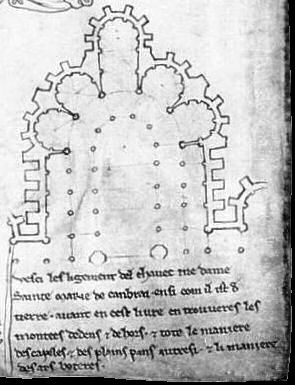
From Villard de Honnecourt’s
sketchbook
text below translates as: “Here is the plan of the
chevet of Notre Dame
Sainte Marie de Cambrai as
it rose from the earth [as it was built]”
“This cathedral was destroyed at the beginning
of the nineteenth century, but by an extraordinary piece
of luck, and thanks to a photograph of a no longer existing
model of Cambrai, we can admire the choir which was
built at the time of Villard, perhaps by the master
himself. This model was one of a secret collection of
models of strategically important towns and their immediate
surroundings. The models, which were Louis XIV’s
idea, were obviously kept from the public and from foreign
diplomats. They continued to be made throughout the
eighteenth century and even in part of the nineteenth
century. Today they have no military importance and
make a very worthwhile display in the Musée des
Plans-Reliefs which is temporarily housed on the top
floor of the Hôtel des Invalides. When Paris was
occupied in 1815, the Germans took the opportunity to
remove some of these models, including the one of Cambrai
and its cathedral, to Berlin, where it was put in the
Zeughaus. Unfortunately it was destroyed during the
bombing of Berlin in 1944. The photograph of the model
is all that remains of the cathedral.” [Quoted
from The cathedral builders by Gimpel]
Cambrai cathedral was completed in 1274. In 1791, the
cathedral was assigned to the “culte constitutionelle”,
the version of the Catholic Church as sanitised by the
Revolutionaries, but was damaged in the following
year, and in 1793 it was converted into a grain store.
In 1796, the cathedral was sold to Blanquart, a Saint-Quentin
merchant, who progressively demolished the building and
sold the stone. At the beginning of the first French Empire
(1804–1814), there was a plan to keep the steeple,
then still standing, as a monument to Fenelon, but the
plan was abandoned as too costly. Then in 1809, a storm
overturned the steeple.
Today, we know this monument by a few documents - two
high precision drawings made by a military painter of
Louis XIV, Van der Meulen; two photographs of the scale
model part as part of a City survey in 1695 by the Royal
Military Engineers (this model destroyed by allied bombing
of Berlin in 1945); statements made on a proposed monument
to Fenelon; a watercolour painted by an English soldier
at the end of the Empire.
The old cathedral was not rebuilt. It was substituted
by a church that was originally the church for the Abbey
of St-Sulpice. This church was built between 1696 and
1703. The abbey church had survived the Revolution because
it became a Temple of Reason. In due course, the building
was re-consecrated, first as part of a bishopric in 1802,
then as part of an archbishopric, and so a cathedral,
in 1841.
It did not escape German attacks in World War One.
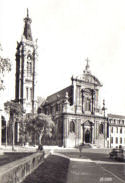 |
 |
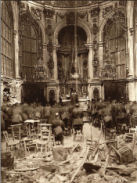 |
| Cambrai cathedral before World War
1 |
Cambrai cathedral after German shelling |
Thanksgiving service in Cambrai cathedral, 13th
October 1918, with Canadian servicemen |
| Click on thumbnails
above for larger versions |
The current cathedral was restored after the end of WW1.
More detailed history at Germans
in France - Cambrai Cathedral.
the shelling
of Reims cathedral
By the time Reims was built, experience allowed the building
of a more solid structure than earlier
gothic cathedrals such as Notre-Dame in Paris. So much so that the main structure of Reims
cathedral even withstood the vandalism of the German
batteries in the First World War. It is said that
Reims cathedral was hit by several hundred missiles. [Thus,
Reims cathedral is almost entirely a modern restoration
job.]
In 1914, the XIIth Saxon Corps had entered Reims.
“An hour later a strange detonation was heard;
then a second; the a third. ... At the third explosion
a splinter of shell fell at my feet. It was in the Place
Belletour. I knew then what it meant. Without any warning,without
any one knowing why, a savage bombardment was being
launched on the city. ...
“... the Saxon officers, who had believed at
first that this was a counter-offensive of our own,
more astonished than anyone at seeing themselves bombarded
by their own guns—it was necessary to take them
splinters of their own shells to convince them—had
hurriedly sent two of their number ... to report and
obtain a cessation of the bombardment. ...
“It was another army corps—a Prussian corps,
which was ignorant of the arrival of the Saxons, and
had ruined the city on account of a couple of envoys.”
The envoys, two officers of the Prussian Guard, had set
out for Reims the evening before, but had not returned.
The conclusion was “they were prisoners and without
troubling to obtain further information, the city was
made to suffer the consequences.”
In fact, the envoys had taken a different route to the
French lines and had never set foot in Reims. As well
as the damage to the cathedral and other parts of the
city, sixty civilians were killed and a further hundred
and forty injured. A hundred and eighty-two shells fell
on Reims, though fifty-six did not explode.
By 5th October 1918, there had been 857 days of bombardment.
“THE CATHEDRAL OF REIMS
For half a century Germany has been dominated by two
forms of pride--military ambition and intellectual pedantry,
the one engendering the other. She carried self-esteem
and self-admiration to such a pitch that she believed
herself, and told herself, that she was a nation without
peer, a people-type marked out to be the head of the
human race. She made herself a soldier that she might
realize her dream, militarism being thus the servant
of German Thought. She was to become" Greatest
Germany," to extend ever farther afield, to mount
ever higher, by force of arms and the spread of her
culture: Deutschland über alles, Germany
before all and above all, was to dominate everywhere,
and to rule the world.
“She had brought into being a formidable engine
of war. She produced the illusion, or the impression,
of a certain scientific superiority, ponderous and massive,
like her soldiers, and like them also in strength. She
paraded this achievement with such an air of assurance,
with such haughtiness, such an accent of superb arrogance,
that she imposed her conviction upon others.
“And these two boasts fall simultaneously, in
the same catastrophe: the military boast has been shattered,
though not ingloriously, in those combats of giants
such as humanity has never hitherto witnessed; the intellectual
boast has foundered miserably amid orgies of cruelty,
of villainies, of stupid malevolence, which are only
to be matched in the worst periods of history, and are
on a par with the vilest excesses of barbarian hordes.
“The enormous power of the German armies and
their monstrous engines of war astounded the world;
but their crimes have sickened it; so that it is hard
to say which feeling is uppermost-surprise at the obstinate
resistance of the Kaiser's soldiers, or indignation
at the savage destruction they have wrought.”
[pp. 1-2, Preface, The Cathedral
of Reims - the story of a German crime by
Maurice Landrieux, Bishop of Dijon; translated by Ernest
Williams]
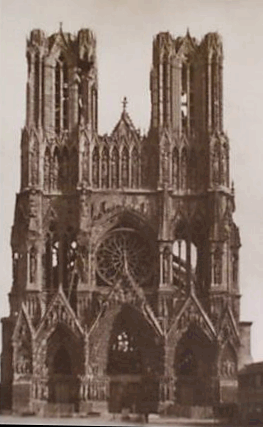 |
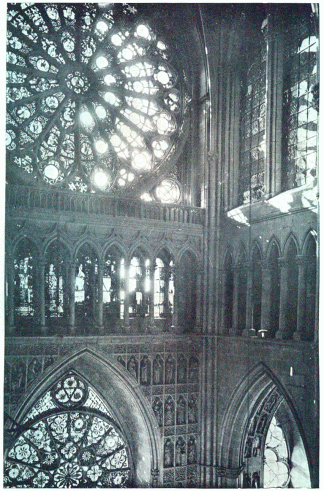 |
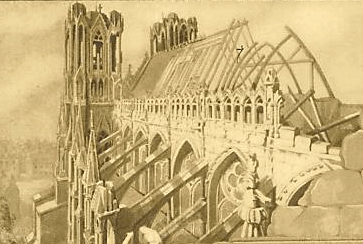
|
|
The following map shows where shells
fell around Reims cathedral during 1914 to 1918. The cathedral
itself received a total of 287 shells. Shells are gun-launched bombs of various types, including incendiary
and gas.
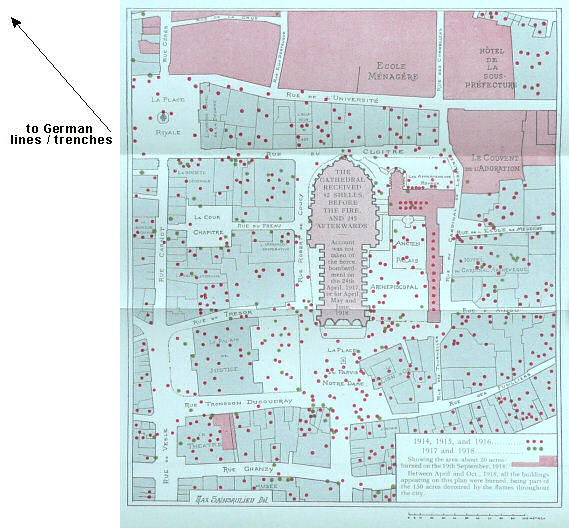
p.32, Rheims
“
In 1915 and 1916, the cathedral was struck a hundred times, but
it was the bombardments of April 15,19 and 24, 1917, that it suffered
most. For seven consecutive hours, at a rate of twelve per hour,
the Germans fired 12-in., 14-in. and 15-in.
shells on the edifice, causing terrible havoc, especially to the
south-western side.”
p.31
“Destroy, reduce to ashes, this Rheims basilica, where
Chlodovic was consecrated and where was born that Empire of the
Franks, those turncoat brothers of the noble Germans.” [Johann
Joseph Goeres, April 1814]
More detailed history
at Germans
in France - Reims cathedral.
Noyon
cathedral
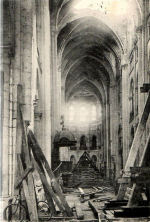 The
cathedral was the target of much revolutionary zeal and bile,
as Noyon was so closely associated with the French monarchy. In
1793, the statuary of the west and transept portals were ordered
destroyed, an order that was carried out with great efficiency.
Only four small corbel figures survived,
which had been covered up. So the marvels of the statuary’s
carving has been lost. The
cathedral was the target of much revolutionary zeal and bile,
as Noyon was so closely associated with the French monarchy. In
1793, the statuary of the west and transept portals were ordered
destroyed, an order that was carried out with great efficiency.
Only four small corbel figures survived,
which had been covered up. So the marvels of the statuary’s
carving has been lost.
Noyon was probably the most important
cathedral after Reims. It was very early: 1150 - 1200. Fortunately,
its big brother at Laon remained undisturbed, and the restoration at Noyon, continuing
almost up to the Second World War, has recovered as much as could
be expected.
The revolutionary government eventually ordered
the cathedral be sold, but the price put on it was so high that
this did not happen, and eventually the horrors of the revolution
receeded. It was used as a hay barn, granary, stable and dance
hall, again the usual combination of dedicated revolutionary desecration
and utility.
More detailed history at Germans
in France - Noyon cathedral.
Soissons
cathedral

After Soissons cathedral was bombarded in
early to mid 1918
A twelfth-century cathedral, used
as a warehouse during the 1789 Revolution and much damaged, received
its worst affronts during World War One when the tower’s
upper section and the nave’s first three bays were completely
destroyed.
The cathedral was expertly restored in the late
1920s.
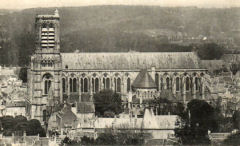 |
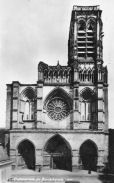 |
 |
| Soissons cathedral prior
to the First World War |
The west facade, Soissons
cathedral |
the interior of Soissons cathedral
after WW1 bombardments |
| Click
on thumbnails above for larger versions |
More
detailed history at Germans
in France - Soissons Cathedral.
Arras
and Verdun cathedrals
 The
situation at Arras was very similar to that at Cambrai during
the first world war. For more detailed information, go to Germans
in France - Arras cathedral. The
situation at Arras was very similar to that at Cambrai during
the first world war. For more detailed information, go to Germans
in France - Arras cathedral.
Verdun, also close to the front line, was badly damaged
by German bombardments. For further information, go to cathedrals
in lorraine - the three bishoprics.
St.
Quentin cathedral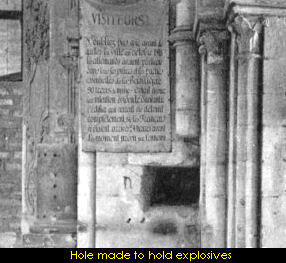
The
city of St. Quentin was occupied by the German army from August
1914 to October 1918. During this time, there were many attempts
to dislodge the Germans, resulting in the near total destruction
of the cathedral, leaving just the outer walls.
When St.
Quentin was relieved by French troups on 1st October 1918, chasing
the Germans so they left the city precipitately. On entering the
cathedral, the French soldiers were outraged to discover in the
walls and pillars, ninety-three holes made and filled with
explosives so the edifice could be blown up as the Germans had
done to the donjon
of Coucy in 1917. Some of the holes were 110 cm deep, 80 cm
wide and 70 cm high. A German engineer captain was found left
behind to do the diabolical chore, but he was stopped in time.
For more detailed information, go to Germans
in France - St. Quentin cathedral.
Also see Amiens
cathedral.

“We taught them a lesson in 1918.
And they’ve
hardly bothered us since then.” Tom Lehrer
|
|

|
German occupation during
World War Two
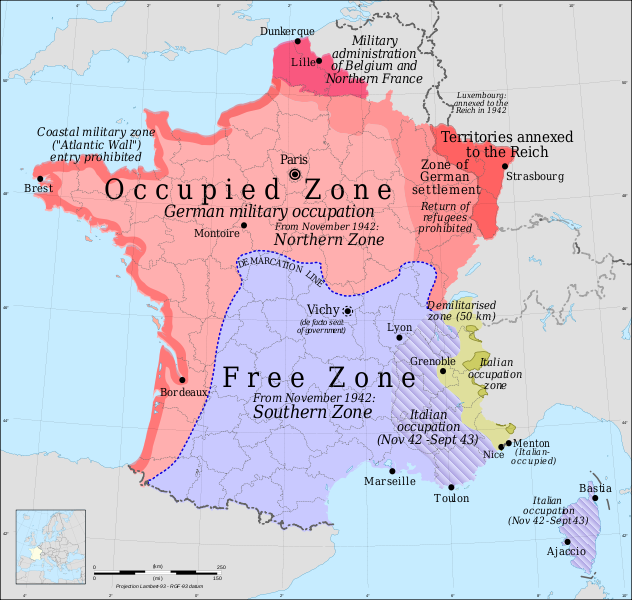
Map of Free and Occupied Zones in France
during the German WW2 occupation. Source: Wikicommons
Southwest
France
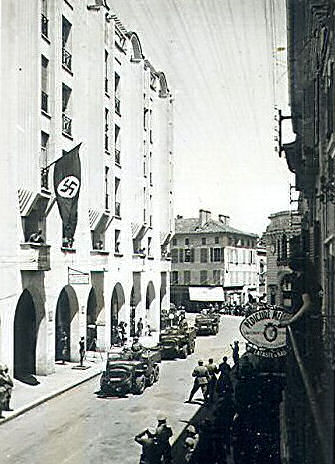
Strutting in Dax
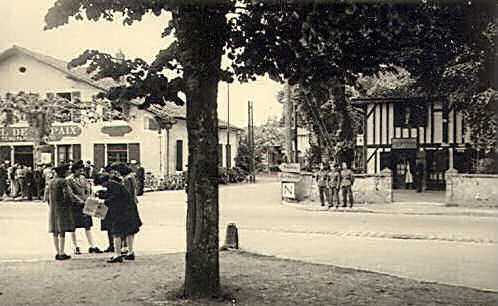
The invaders eying up the local talent in Magescq

transbordeur
bridges demolished or destroyed during WW2
The
French transbordeur bridges erected close to or in naval bases
or sea ports did not fair well during World War Two.
Rouen:
Destroyed by French troops in 1940 in order to slow the German
advance.
Brest:
Erected in the naval base, this transbordeur was damaged in 1944.
It was demolished completely in 1947.
Marseilles:
Destroyed by the Germans in 1944, on the day before marseilles
was liberated by the Allies.
Bordeaux:
Never completed, the two pylons were dismantled by the French so
they would not be available to the German invaders.
For
more information and illustrations, go to
transbordeur/transporter
bridges in France and the world 1: why, who, when, where.

Vandals in France book

Franco
faces down Hitler for three years
The great prize that
Hitler wanted was to capture the fortress stronghold of Gibraltar.
From there, Hitler could cut off the Mediterranean. Franco had
other ideas.
“It is fashionable at the present time to dwell
on the vices of General Franco, and I am therefore glad
to place on record this testimony to the duplicity and
ingratitude of his dealings with Hitler and Mussolini.
I shall presently record even greater services which
these evil qualities in General Franco rendered to the
Allied cause.”
[Abstracts of the war memoirs of Winston Churchill, Their Finest Hour, part 4; in Life,
14 March 1949, p. 87]

“General Vigón reported to Franco that Germany
had suddenly begun reinforcing its Third Air Force around Bayonne right at Spain’s doorstep. And in addition to
the twenty divisions still at
Irún-Hendaye,
more Wehrmacht divisions were arriving in an
area south of Bordeaux.”
[Hitler stopped by
Franco, p. 223. This refers to mid-July,
1941.]

“In the north, on the only two roads over which it was
possible to pass into Spain there suddenly appeared massive concrete
fortifications and roadblocks. Spain did not lack sand and cement,
and hundreds of tons of concrete were poured as if overnight.
To the sides of the roads the engineers used dynamite to create
vast craters as tank traps. Everywhere that vehicles and men on
foot might pass, obstacles were placed to make passage impossible.
Franco and his Ministers had mobilized the Army Engineers in an
operation without name but in direct reply to Ilona.
“They
divided the Pyrenean area into five defensive regions. The key
frontier bridge that spans the Bidesoa River that links Spanish
Irún to French Hendaye, in bad condition, was weakened
still further and mined with enough explosives to blow it out
of existence in sixty seconds. Teams of men rotated duty twenty-four
hours a day to protect the mines from being defused, or to detonate
the charges when ordered.
“Five dams were prepared
to be opened wide enough so that within hours their waters could
flood the region, making it as marshy and boggy as later in the
year the winter weather would do naturally. Farmhouses became
arsenals for the implements of guerrilla warfare: knives, guns,
hatchets, gasoline, dynamite? Anything that could kill a soldier
and destroy his vehicles.
“Finally, the Army's rosters were studied for
men who came from the north and then one hundred and
twenty thousand of them were transferred and stationed
as close to their homes as possible: a fundamental of
guerrilla warfare being the intimate knowledge of one's
terrain.” [Hitler
stopped by Franco, p. 222]

“The two guardias civiles at the customs barrier at Irun
stood at their posts, looking into France at the German tanks
and trucks and half-tracks, at the field artillery and the thousands
of tents that housed the hundreds of thousands of men of the Wehrmacht.
They stared at them as they had stared at them in never-lessening
terror for one week short of three years.
“ Then
they heard the sound of engines starting up, in a low and distant
roar. They saw a heavy cloud of dust rising and heard the roar
deepening as more and more engines awakened. Then, through binoculars
they could see the vehicles moving, turning ... away from Spain.”
[Hitler stopped by
Franco, p. 271. This applies to 20 June,
1943.]
See also Fascism
is socialism: Franco was not a Fascist.
related material
bibliography
 |
The
cathedral builders
by Jean Gimpel,
Michael Russell
Publishers, 1980 |
|
 |
The
Cathedral of Reims - the story of a German crime by Maurice
Landrieux, Bishop of Dijon; translated by Ernest Williams
Kegan Paul, Trench, Trubner & Co. Ltd., London, 1920 |
 |
Rheims
and the battles for its possession
published by Michelin
and Cie, 1919 |
|
 |
Hitler stopped by Franco by Boyar & Boyar,
Marbella House
amazon.co.uk
$19.95 [amazon.com]
Marbella House, 2001
ISBN-10: 0971039208
ISBN-13: 978-0971039209 |
 |
Les
Vandales en France, 1914, 1915
L’Art et les Artistes,
1915 |
These two following books are clumsy
and mawkish but popular attempts to weave ‘romance’
against a background of the horrors and seediness of the
German attacks and occupations, during the First and the
Second World Wars respectively, in France. The first book, Birdsong, is considerably more use than the second.
You may find them interesting to read for the background
research.
 |
Birdsong by Sebastian Faulks
£4.00 [amazon.co.uk]
Vintage, 1997
ISBN-10: 0679776818
ISBN-13:
978-0679776819
$10.85 [amazon.com]
Vintage, 1997
ISBN-10: 0679776818
ISBN-13:
978-0679776819 |
 |
 |
Charlotte Gray by Sebastian Faulks
£5.59 [amazon.co.uk]
Vintage, 1999
ISBN-10: 0099394316
ISBN-13:
978-0099394310
$11.20 [amazon.com]
Vintage, 2000
ISBN-10: 0375704558
ISBN-13:
978-0375704550 |
 |

- Some reference keywords/tags:
- cathedrale,france,germany,1870,1914,1940,invasion,occupation,
end notes
- This is a romantic speculation.
There is no known evidence for this claim, but an accretion
of unsupported myths. We know nothing about Villard
de Honnecourt outside the existence of his pages of
sketches.
- German shells during the first
world war included 12-in., 14-in. and 15-in shells.
| shell diameter |
range |
| 12 inch/30 cm |
6-7 miles |
| 14 inch/35 cm |
30 miles |
| 15 inch/ 38 cm |
24-26 miles |
A 14-inch shell would weigh approximately 850lbs/390kg.
These are fired from huge guns, whether cannon or mortars/howitzers.
They had originally been mounted of battleships. On
land, some were then mounted on trains, able to absorb
the heavy recoil by the gun carriage rolling about
100 yards along the line.
- corbel
- A corbel is the supporting plinth of a pillars
and or column. As such, it is a structural part
of the cathedral.
- Hitler had over two hundred divisions
at this time. This was no token force and continued
in place while he was attacking Russia. Of course, Germany
was impoverishing France in support of its mad ambitions.
|
|





















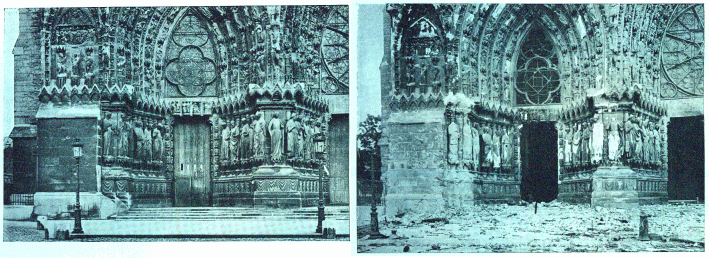
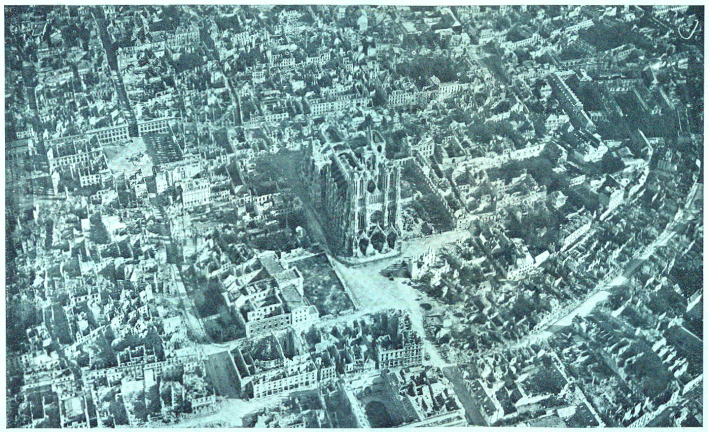

 The
cathedral was the target of much revolutionary zeal and bile,
as Noyon was so closely associated with the French monarchy. In
1793, the statuary of the west and transept portals were ordered
destroyed, an order that was carried out with great efficiency.
Only four small
The
cathedral was the target of much revolutionary zeal and bile,
as Noyon was so closely associated with the French monarchy. In
1793, the statuary of the west and transept portals were ordered
destroyed, an order that was carried out with great efficiency.
Only four small 



 The
situation at Arras was very similar to that at Cambrai during
the first world war. For more detailed information, go to
The
situation at Arras was very similar to that at Cambrai during
the first world war. For more detailed information, go to 













